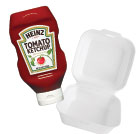
While consumer packaged goods are making progress with innovations like upside-down bottles, a lot of grocers are still putting takeout in negatively perceived packaging like EPS clamshells.
It was just about five years ago that consumers told us that takeout from Chinese restaurants came in packages that didn’t leak, while packages of prepared foods from supermarkets “leaked all over the place.” There have been marked improvements in takeout packages, but how do shoppers who were turned off before find out about the improvements? In fact, they often don’t. It’s worse than the problem facing General Motors, which uses advertising to try to persuade consumers that their cars’ quality is now on a par with the imports. In the case of prepared foods, the only advertising for new packaging appears in trade magazines, where the only consumers who see it are industry spouses.
Among the results that popped out of our latest Packaging Report Card survey were the poor ratings that our shoppers continue to give to the packaging of prepared and takeout food. Only 36% of our respondents gave prepared-food (takeout) packages good marks-that is, ratings of 4 or 5 on a scale where 1=Awful, 2=Poor, 3=Fair, 4=Good, and 5=Excellent. A hefty majority rated prepared-food packages Fair or worse.
Just to make sure that those ratings weren’t a fluke, we checked the ratings for takeout clamshells under a question about “types of packages.” Here, the ratings were even worse. Only 18% of the respondents under 50, and 33% of those 50 and over, gave clamshells good marks. Those are substantial levels of dissatisfaction.
And for those of you who remember Statistics 101, the “modal” response for prepared-food packaging was an alarming 2, or Poor. (The mode is the answer most respondents choose. That is different than the mean, which is based on arithmetic, or the median, which is the number in the middle of the array counting from the top or bottom.) The mode is rarely used because it’s simplistic, but it’s a very powerful measure that expresses what most people say, think, or do.
Now, you may think these consumers are contrary complainers, but we find that they generally err on the side of kindness, and while they are comfortable saying something is Fair, they have to be pretty disgruntled to call it Poor or Awful.
So take heed! There are a lot of shoppers out there who think that takeout foods come in poor packages, which is reason enough for many of them to bypass the prepared-food counter in favor of something else, perhaps frozen entrees, where the mode rating for packaging is 4, or Good.
The lag in recognizing improvements has been especially long in the case of prepared-food packaging. The poor ratings may be surprising to many readers who “know” how much better prepared-food packaging has gotten, how much of it is far more consumer-friendly than it was in the pre-recession days of 2004.
There are packages with significant amounts of recycled content, packages that really seal, packages with less wasted air space, space-efficient squared packages, easy-open and resealable packages, packages that retain freshness, packages that take pretty extreme temperatures, and packages with clarity and shine that makes the food inside look as good or even better than it really is. With all those improvements, how could so many consumers dish out such low ratings?
If you are nodding your head in agreement, maybe you’ve seen all those improved packages in the same places I have, e.g., on the pages of trade magazines and exhibits at trade shows. What’s out in the stores where the shoppers are shopping is a crazy quilt of packages that includes Styrofoam clamshells that make eco-sensitive shoppers want to hide in shame, plastic cups that crack if they aren’t handled with kid gloves, and paperboard cartons with “weird hard-to-close tabs that keep popping out and flopping around.”
Some supermarkets have just recently upgraded the packaging in their prepared food departments. Some haven’t upgraded it yet. Many shoppers still think that prepared foods travel home in leaky clamshells.
Prepared foods aren’t like the packaged products that fill the high-traffic center aisles of grocery stores. Prepared foods are almost always on the stores’ perimeter, which is heavily shopped, but shoppers who aren’t out to buy prepared foods don’t even notice them or the packages they go home in.
They know that raisins are now available in canisters as well as boxes, that Heinz ketchup bottles stand upside down, and that ground coffee comes in hand-friendly plastic jugs with big screw tops that are super-easy to turn as well as traditional cans and brick-packs. But prepared foods come in a hodgepodge of packages that vary from store to store as well as product to product. And unless special efforts are made to put improved prepared-food packaging in their sight lines, shoppers aren’t going to know they are changing. They aren’t checking in with prepared-foods associates to see whether or not they’re still using the old packages they hated.
To reach these shoppers, supermarket operators, deli people, prepared foods merchandisers, and the packaging suppliers that make and market new and improved prepared-food packages need to invest in attractive signs and displays that show and tell shoppers about the new packages and how they make it easy to take prepared food home without leaks, spills, and environmental degradation. Otherwise, the lag is going to linger far longer than it needs to.F&BP
Mona Doyle is CEO of The Consumer Network Inc., a firm that regularly takes the pulse of consumers on packaging issues. She publishes The Shopper Report newsletter. Contact her at 800-291-0100 or mona@consumernetwork.org.
